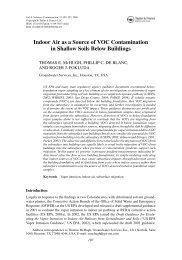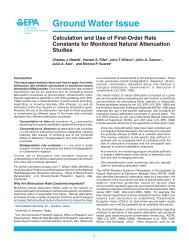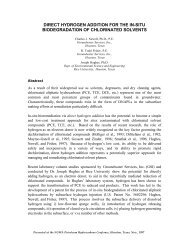Passive Soil Vapor Extraction - GSI Environmental Inc.
Passive Soil Vapor Extraction - GSI Environmental Inc.
Passive Soil Vapor Extraction - GSI Environmental Inc.
- No tags were found...
You also want an ePaper? Increase the reach of your titles
YUMPU automatically turns print PDFs into web optimized ePapers that Google loves.
SRNL-STI-2009-00571Rev. 1• Implementation of either system eliminates the need for costly and high-maintenanceinfrastructure typically associated with an ASVE application, such as high powerelectric blowers, vacuum manifold systems and electrical lines and control boxes.• Operating and maintenance costs are generally low and the units can be expected tooperate continuously for the life span of the remediation with little or no intervention.3.2 PSVE Technology WeaknessesIn general, PSVE technologies suffer from the same limitations as those documented forASVE, but with the additional limitation that the removal rates and radius of influence forextraction wells will likely be lower than ASVE applications.• SVE technologies are limited to vadose zone contamination and do not directlyaddress existing groundwater contamination in most situations.• High moisture levels or high pore water saturation can limit air permeability andreduce the rate of contaminant mass removal.• The presence of preferential pathways, such as abrupt changes in lithology, deeproot zones, or anthropomorphic features, could result in low air flow due to vacuumdisruptions or more likely, short-circuiting to the atmosphere.In addition to these limitations,• PSVE technologies are typically not appropriate to treat high levels of VOCs incomparison with ASVE. High contaminant mass removal rates would probablynecessitate above-ground vapor treatment which may off set the benefits of a lowenergyextraction system. Furthermore, it would be harder to gain regulatoryapproval for a passive treatment technology at these sites when an activeremediation technology would probably be more effective in terms of mass removalrates.• Low and intermittent extraction of air at sites employing barometric pumping may notbe sufficient to meet the target mass removal rates. Depending on the site lithologyand barometric pressure gradient, peak flow rates may be as low as 1 cubic foot perminute (cfm), and may last only a short period during each 24-hour period. For sitesemploying solar- or wind-powered SVE, the highest vacuum possible still may notproduce desirable airflow rates.• Barometric pumping is generally not suitable for sites with limited lithologicstratification or a shallow groundwater table. These factors allow vertical movementof air from the surface, which circumvents the barometric pumping process.• Due to the small zone of capture around each well, sites employing PSVEtechnologies may generally require more extraction wells than conventional activeSVE systems, thus adding to the overall cost of site preparation, installation and20 Enhanced Attenuation Technologies<strong>Passive</strong> <strong>Soil</strong> <strong>Vapor</strong> <strong>Extraction</strong>






